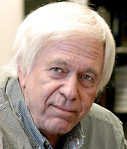Unraveling the mysteries of the origins of the universe is a vast and seemingly insurmountable task. But recent scientific breakthroughs are providing researchers with new tools to reach their goal.
In his inaugural lecture as the Victor F. Weisskopf Distinguished University Professor of Physics in LSA, Gordon Kane will explain how recent progress in string theory, plus existing and forthcoming data — particularly from the European CERN Large Hadron Collider — allows us to make significant progress on understanding ultimate questions about the physical universe. He will deliver the lecture “The Bottom of the Iceberg — How Well Do/Can We Understand the Underlying Laws of the Physical Universe?” at 4 p.m. March 6 in the Rackham Amphitheatre.

Photo by
Distinguished University Professor is the highest professorial title granted at U-M. A reception will follow the lecture, which is free and open to the public.
Kane works in the forefront of theoretical particle physics and cosmology to unravel the mysteries of the universe, including the origin of particle masses and the whereabouts of dark matter. He has developed and extended theories beyond the Standard Model, including substantial contributions to string theory. The successful and well tested Standard Model of particle physics provides a full mathematical relativistic quantum field theory of how the basic forces of nature (the strong, weak and electromagnetic forces, plus gravity) act on the basic constituents (quarks and electrons) to form the world we see.
Kane is one of the leading proponents of supersymmetry, which would require that for each observed particle there is a super-partner, as yet unseen. His models have set the standard for supersymmetry investigations, including experiments at the Large Hadron Collider (LHC). The LHC, the most complicated and largest scientific research facility in history, collides protons at very high energies in order to produce heavy or rare particles that have not been seen before now.
“The European Large Hadron Collider in Geneva, Switzerland is now operational and it will help us answer questions about how the universe works,” Kane says. “The origin of the universe is now a research problem. We are way ahead of where most people think we are in understanding the natural universe.”
Kane teaches a highly regarded graduate course on the Standard Model to physics students from theoretical and experimental backgrounds and has mentored more than a dozen doctoral students.
His approximately 200 published papers are highly cited and include agenda-setting original work and clear reviews on otherwise impenetrable subjects. One review he co-authored, reprinted as “The Higgs Hunter’s Guide” (Perseus Books, 1990), is considered an authoritative resource for investigations of the Higgs boson, a particle hypothesized by the Standard Model.
Kane has authored or co-authored a number of popular books, including “The Particle Garden: Our Universe as Understood by Particle Physicists” (Helix Books, 1996) and “Supersymmetry: Squarks, Photinos, and the Unraveling of the Ultimate Laws of Nature” (Perseus Books, 2000).
As director of the Michigan Center for Theoretical Physics, he has brought more than 2,000 visiting scientists to the U-M for workshops on topics in the forefront of physics. He also is an adjunct professor in the School of Art & Design.
Kane has served on U-M’s Finance Committee and the Budget Priorities Committee. He is a senior fellow of the Michigan Society of Fellows; and a fellow of the American Physical Society, the American Association for the Advancement of Science and the British Institute of Physics. He also has been a Guggenheim Fellow (1971-72) and was awarded the 2012 Julius Edgar Lilienfeld Prize of the American Physical Society.
He advises the U.S. Department of Energy and the National Science Foundation (NSF), most recently as chair of the theoretical physics subpanel of the NSF’s Committee of Visitors for the Physical and Mathematical Sciences Division. Kane earned his doctorate in physics at the University of Illinois and joined the U-M faculty in 1965.

